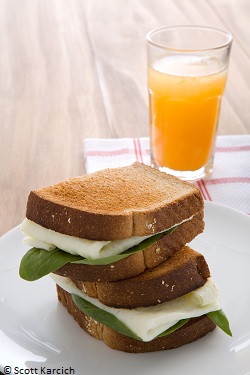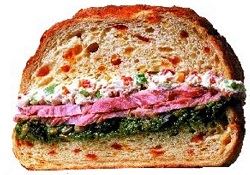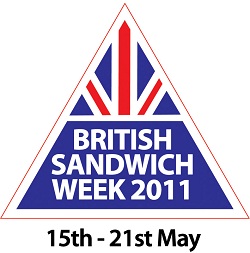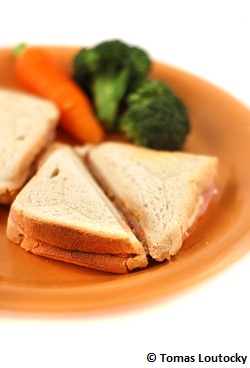British Sandwich Week 15th -21st May 2011
British Sandwich Week takes place in May each year and is a celebration of the ‘sandwich’ created by the 4th Earl of Sandwich in 1762.
From its humble beginnings as a ‘snack’ - taken so that the Earl could eat without having to stop playing cards - the sandwich is today by far the most popular hand held meal eaten in the UK.
Facts About Sandwiches

- British consumers manage to munch their way through over 11.5 billion sandwiches each year – and more than half of these were made and eaten in the home.
- Well over 3M sandwiches are purchased from retail or catering outlets each year and we paid over £6M for them – making the average price of a sandwich almost £1.91
- Many consumers buying sandwiches in busy City locations will not queue for more than 2 minutes!
- The record for creating the most expensive sandwich ever made is claimed by chef Tom Bridge whose Lancaster Cheese Sandwich which was sold on ebay in 2006 for £345. The creation included white Umbrian truffles at £1700 per kilo. The full recipe can be found on the British Sandwich Association site www.sandwichesonline.org.uk.
- The world's largest 'pre-packed' sandwich is believed to be one created by Roberts Bakery in Norwich that was 2.5 metres long (down the longest edge) and encased in 1/2" thick perspex packaging. It was filled with Marmite, Princes Tuna & Hellmann's Mayonnaise and weighed the same as 1,000 loaves.
- Britain’s biggest sandwich retailer in the UK is now the American franchise chain Subway which has shot ahead of the UK’s biggest retailers, including Tesco, Greggs and Marks & Spencers in the sandwich stakes in the value of the sandwiches they sell. However, Tesco outsell them in the numbers of sandwiches sold by several million.
- The first sandwich - in name at least - was created by the 4th Earl of Sandwich in 1762 when he called for some ‘cuts of beef ‘ to be placed between toasted slices of bread so that he could continue gambling while he ate. At least it was the first toasted sandwich! It is believed that sandwich making dates from well before this time but was largely a food eaten by peasants. The Earl’s request elevated the humble sandwich from the fields to the tables of the aristocracy.
- Chicken remains the No.1 most popular filling in commercially made sandwiches accounting for around 30% of all commercially made sandwiches – we eat some 40,000 tonnes of chicken in sandwiches each year. However, chicken is gradually losing its dominance, with both egg and ham sandwiches gaining in popularity in the last year.
- Ham and cheese are the favourite sandwich filling in home-made sandwiches.
- Around 58% of all commercially bought sandwiches are made with traditional square sandwich bread.
- Wraps, which were losing ground a year ago, have regained their popularity in the last 12 month with almost 25% growth in sales! However, wraps account for only about 5% of all sandwich sales in major retailers. The big new thing with wraps has been the hot wrap, with a number of new products being launched recently. They really do taste great hot!
- Panini sandwiches are also gaining in popularity – last year their sales rose by 14% in major retailers, although they still only account for around 2% of sandwich sales.
- More sandwiches are consumed in hot weather than when it is wet or cold.
- Some 3.2 billion sandwiches are carried out of the home each year in lunch boxes.
- The UK sandwich industry employs more people than the UK agricultural industry. It is estimated over 300,000 people are now employed in the commercial sandwich sector.
- 'Sandwich' is also a town in Kent, although the name has no direct connection with a sandwich. It's origin comes from the Saxon meaning for 'Sandy Place' or 'Place on the Sand'. The town is likely to have been formed in Roman times although the first recorded mention is in 640AD. The town is also the birthplace of Viagra.

About a third of all the sandwiches we buy outside the home contain chicken in one form or another but even this top seller has lost some favour with volume sales down by over 7% in the year to March 2011. Meanwhile egg and ham sandwich sales are up by around 11% and 9% respectively, according to research by Kantar among leading sandwich retailers.
There is also some evidence that consumers find making lunchbox sandwiches a chore and many return to buying sandwiches after a few weeks because the choice is so much greater than the left-overs in fridges. The savings can also be limited if wastage is taken into account.
In the home, ham and cheese continue to dominate – which also suggests that we are all, perhaps, a little less adventurous when it comes to making our own sandwiches – or maybe it’s because those tend to be the only ingredients we have in the fridge!

While other breads, come and go in popularity – in the last year paninis and wraps have been the in-choices – they continue to account for a very small share of the overall market. Wraps currently have about 4% share and paninis less than 2%.
For more facts and information visit: www.sandwichesonline.org.uk
